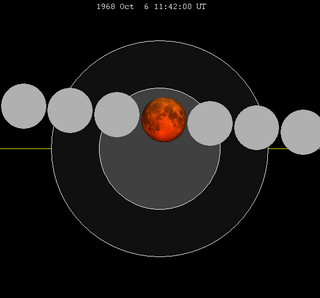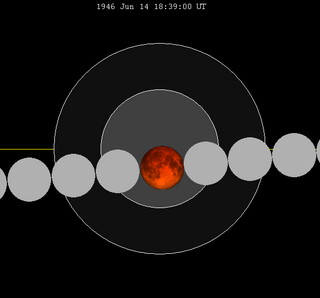
A total lunar eclipse took place on October 27–28, 2004, the second of two total lunar eclipses in 2004, the first being on May 4, 2004. It was the first lunar eclipse to take place during a World Series game, which when seen from Busch Memorial Stadium in St, Louis, Missouri, provided a surreal sight on the night the Boston Red Sox won their first World Series in 86 years to end the Curse of the Bambino. Occurring 5.6 days before apogee, the Moon's apparent diameter was smaller. The moon was 10.1 days after perigee and 5.6 days before apogee.

A total lunar eclipse will take place on August 7, 2036. The southern tip of the moon will pass through the center of the Earth's shadow. This is the last central lunar eclipse of Saros cycle 129.

A total lunar eclipse occurred on Tuesday, 8 November 2022. The southern limb of the Moon passed through the center of the Earth's shadow. It surpassed the previous eclipse as the longest total lunar eclipse visible from nearly all of North America since 17 August 1989, and until 26 June 2029. Occurring only 5.8 days before apogee, the Moon's apparent diameter was smaller. The next total lunar eclipse will take place on 14 March 2025. A lunar occultation of Uranus happened during the eclipse. It was the first total lunar eclipse on Election Day in US history. This event was referred in media coverage as a "beaver blood moon".

A total lunar eclipse occurred at the Moon's descending node on 27 July 2018. The Moon passed through the center of Earth's shadow in what was the first central lunar eclipse since 15 June 2011. It was also the second total lunar eclipse in 2018, after the one on 31 January. It was the longest total lunar eclipse of the 21st century, but not the longest in the 3rd millennium. The longest total lunar eclipse of the 3rd millennium will occur on May 12, 2264, lasting 106 minutes and 13.2 seconds, which will be the longest total lunar eclipse since 2000, and the longest one until 3107.
A total lunar eclipse took place on Tuesday, July 6, 1982, the second of three total lunar eclipses in 1982, and the only one that was in the descending node. A dramatic total eclipse lasting 1 hour and 46 minutes plunged the full Moon into deep darkness, as it passed right through the centre of the Earth's umbral shadow. While the visual effect of a total eclipse is variable, the Moon may have been stained a deep orange or red colour at maximum eclipse. This was a great spectacle for everyone who saw it. The partial eclipse lasted for 3 hours and 56 minutes in total.

A total lunar eclipse will take place on November 18, 2040. The southern limb of the moon will pass through the center of the Earth's shadow.

A total lunar eclipse took place on Thursday, June 25, 1964. The moon passed through the center of the Earth's shadow.

A partial lunar eclipse occurred on the 16 and 17 July 2019. The Moon was covered 65.31% by the Earth's umbral shadow at maximum eclipse.

A total lunar eclipse will take place on Thursday, April 14, 2033.

A partial lunar eclipse will take place on November 30, 2039. At 3 hours 26 minutes, it is the longest partial lunar eclipse since November 19, 2021, which is the previous member of Lunar Saros 126.

A total lunar eclipse took place on Wednesday, October 18, 1967, the second of two total lunar eclipses in 1967, the first being on April 24, 1967.

A total lunar eclipse took place on Sunday, October 6, 1968, the second of two total eclipses in 1968, the first was on April 13, 1968. The tables below contain detailed predictions and additional information on the Total Lunar Eclipse of October 6, 1968.

A partial lunar eclipse took place on Saturday, August 26, 1961, the second of two partial lunar eclipses in 1961. This nearly total lunar eclipse of Saros cycle 137 preceded the first total eclipse on September 6, 1979. It took place around lunar perigee, therefore as a result, the Moon appeared larger than usual. It was the largest partial lunar eclipse since October 28, 1939, making it the second largest partial lunar eclipse of the 20th century.
A total lunar eclipse took place on Monday, September 15, 1913. The moon passed through the center of the Earth's shadow.
A total lunar eclipse took place at the Moon's descending node of the orbit on Tuesday, May 24, 1910 with an umbral eclipse magnitude of 1.09503. A total lunar eclipse takes place when the Earth comes between the Sun and the Moon and its shadow covers the Moon. Eclipse watchers can see the Moon turn red when the eclipse reaches totality. Total eclipses of the Moon happen at Full Moon when the Sun, Earth, and Moon are aligned to form a line. The astronomical term for this type of alignment is syzygy, which comes from the Greek word for being paired together. The Moon does not have its own light but shines because its surface reflects the Sun's rays. During a total lunar eclipse, the Earth comes between the Sun and the Moon and blocks any direct sunlight from reaching the Moon. The Sun casts the Earth's shadow on the Moon's surface. A shallow total eclipse saw the Moon in relative darkness for 49 minutes and 29.5 seconds. The Moon was 9.503% of its diameter into the Earth's umbral shadow, and should have been significantly darkened. The partial eclipse lasted for 3 hours, 35 minutes and 22.9 seconds in total.

A total lunar eclipse took place on Friday, June 14, 1946. The northern tip of the moon passed through the center of the Earth's shadow. This was the first central lunar eclipse of Saros series 129.

A total lunar eclipse will take place on August 18, 2054.

A total lunar eclipse will take place on August 28, 2072.

A total lunar eclipse will take place on September 8, 2090.

A partial lunar eclipse took place on Saturday, October 28, 1939. It was a nearly total eclipse, with 98.77% of the Moon under Earth's umbral shadow. It was the last partial lunar eclipse of the first set of partial eclipses in Saros series 135 as well as the largest partial lunar eclipse of the 20th century.


































